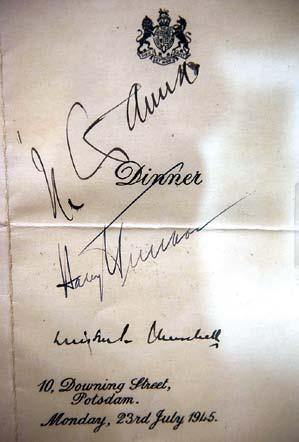WASHINGTON (AP) ― An eclectic mix of some of the most cherished autographs in history ― including those of George Washington and Michael Jackson ― are on display to showcase what curators say is the dying art of the signature.
The “Marking the Mark” exhibit, which opened Friday at the National Archives, includes more than 100 original signatures by the famous and infamous and is the result of a wide search by curators for signatures representing important names and events in history.
 |
The signature of former British Prime Minister Winston Churchill, former U.S. President Harry S. Truman and Soviet General Secretary Joseph Stalin are seen on a dinner program from the Potsdam Conference during a press preview at the National Archives on March 18 in Washington, D.C. (AFP-Yonhap) |
The exhibit proved to be a good way to find interesting stories, said chief curator Jennifer Johnson. For example, the exhibit depicts the stories behind John Hancock’s flourishing signature as well as the basketball signed by Duke University men’s team when they won the 2001 NCAA championship.
“I think the signature gives you maybe a little window into an event,” Johnson said. “It takes you right to the moment.”
Curators looked at the power of the pen in politics, war, entertainment and sports, drawing from the archives and presidential libraries across the country. The exhibit is open until January 2015.
Curators also looked at how the art of the signature may slip away with the use of autopens and electronic signatures.
“As a historian, I think it’s sad, but I think it’s inevitable,” Johnson said. “I do think we’re losing a little bit of uniqueness.”
Beyond papers, curators also are displaying objects representing the “signature styles” of a few historic figures, such as then-Gen. Dwight D. Eisenhower’s tailored Army jacket that became the standard for American troops.
And for the first time, the black and red dress worn by Michelle Obama on the night of the 2008 presidential election in Chicago is going on display. It was designed by Narcisco Rodriguez.
At the heart of the massive exhibition, though, is the written signature in documents dating back to 1783. Some are personal letters and autographs, while other signatures gave documents the force of law.
Frank Sinatra, for example, wrote to President George H.W. Bush in support of the president’s proposed constitutional amendment that would ban burning the American flag after the Supreme Court ruled burning was protected free speech.
“I applaud you long and loud for your reaction,” Sinatra wrote in a letter signed Francis Albert.
Meanwhile, Michael Jackson’s signature is in the archives at least once for his patent application for shoes he helped design with high ankle supports for a dance move in “Smooth Criminal.” The late king of pop wanted to be able to take a deep lean with his dancers without wire supports while they were on stage.
Adolf Hitler’s signature was captured in a will and marriage certificate seized by the Army shortly after the Nazi leader married Eva Braun and they committed suicide together.
The National Archives also is displaying important documents from U.S. history.
There’s the act of Congress signed by President Thomas Jefferson to abolish the international slave trade, a presidential proclamation admitting Missouri to the Union as a slave state and the Supreme Court’s decision overturning Virginia’s ban on interracial marriage that was initialed by Chief Justice Earl Warren.






![[Herald Interview] 'Trump will use tariffs as first line of defense for American manufacturing'](http://res.heraldm.com/phpwas/restmb_idxmake.php?idx=644&simg=/content/image/2024/11/26/20241126050017_0.jpg)
![[Exclusive] Hyundai Mobis eyes closer ties with BYD](http://res.heraldm.com/phpwas/restmb_idxmake.php?idx=644&simg=/content/image/2024/11/25/20241125050044_0.jpg)
